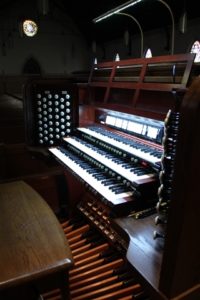
 In 1935, New York trained organist, Adolph Steuterman, reaching his sixteenth year as Organist-Choirmaster, guided the church in their purchase of a new instrument for the nave. A violent storm had torn the roof over the organ chamber and damaged the previous instrument built by the Kimball Organ Company. Mr. Steuterman selected the finest American builder, the Aeolian-Skinner company of Boston, Massachusetts. Considering the economic times, as the country was crawling out of the Depression, it was significant that Calvary could purchase this landmark instrument. In fact, to Calvary’s great fortune, pipe organs had to be sold at less than half the price they would have garnered just six years earlier to keep the factories in production. With such little work, the Aeolian-Skinner company was able to deliver and install Calvary’s new organ in record-breaking time! A process that typically took three to four years for an instrument this size was complete from contract to installation in less than seven months. Its value today is worth nearly forty times the purchase price.
In 1935, New York trained organist, Adolph Steuterman, reaching his sixteenth year as Organist-Choirmaster, guided the church in their purchase of a new instrument for the nave. A violent storm had torn the roof over the organ chamber and damaged the previous instrument built by the Kimball Organ Company. Mr. Steuterman selected the finest American builder, the Aeolian-Skinner company of Boston, Massachusetts. Considering the economic times, as the country was crawling out of the Depression, it was significant that Calvary could purchase this landmark instrument. In fact, to Calvary’s great fortune, pipe organs had to be sold at less than half the price they would have garnered just six years earlier to keep the factories in production. With such little work, the Aeolian-Skinner company was able to deliver and install Calvary’s new organ in record-breaking time! A process that typically took three to four years for an instrument this size was complete from contract to installation in less than seven months. Its value today is worth nearly forty times the purchase price.
As a result of all of these circumstances coming together, Calvary’s instrument is a historic and artistic gem, a treasured work of art. It was built by the finest organ company at a time when the builder actually had the time to dote over every instrument. Only ten other instruments were built in 1935 by Aeolian-Skinner, and the hallmarks of these instruments include superb pipework construction, generous use of first-grade California sugar pine, and excellent wood finish. In addition, Aeolian-Skinner’s technical director at the time, G. Donald Harrison, was making revolutionary changes to the sound and style of instruments he was building. His name is revered among builders and organists today, as one of the most pivotal tonal designers in the history of American organ building. He gave very few instruments his seal, a plate with his signature mounted underneath one of the keyboards, and Calvary’s instrument is proud to bear one as a symbol of his pride in the glorious sounds our organ can make.
Since its installation in 1935, Calvary’s pipe organ has gone through some revisions and additions which have taken it a few steps away from its initial sound with the G. Donald Harrison stamp of approval. However, the north chamber underwent restorative tonal and structural work in 2009, and it is our hope that we may complete the restoration, ensuring its historical and artistic significance, and also its longevity for the service of Calvary’s congregation and the Memphis community.